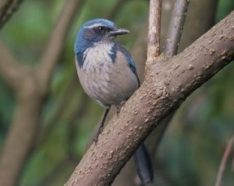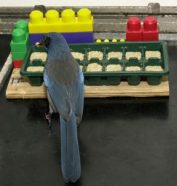Jay Watch
Some birds can get sneaky when spies lurk.
By Emily Sohn
When some birds store food for future meals, they pay close attention to who might be watching when they hide the food. In the presence of thieves, the birds go to extra trouble to save their hoards.
 |
|
Western scrub jay. |
| Photo by Lee Karney, U.S. Fish and Wildlife Service |
Among western scrub jays, certain birds are ranked higher than others. High-ranked birds often steal food from birds of lower rank. Low-ranked birds never steal from their superiors, but they sometimes steal from others of the same rank. In a generous spirit, jays allow their mates to raid each other’s hoards.
In a recent set of tests, scientists gave some yummy waxworms to individual jays. They also provided two ice cube trays, filled with pellets, as hiding places.
 |
|
A western scrub jay goes to a lot of trouble when hiding treats in a pellet-filled ice cube tray to foil a thief. |
| © Science |
When a jay other than its mate was watching, a bird would hide more waxworms in the tray that was farther away from the watcher. Later, when revisiting the trays in private, any hider who’d been watched by a superior during the first episode shifted more treats to other hiding places than did a bird watched by a subordinate, a mate, or no other jay.
Next, the researchers let a jay hide waxworms in a single tray while a jay of similar rank watched. In the second round, there was a different observer and a different tray for hiding food.
When the hider came back to the scene and found one of the original observers watching, it remembered which tray it had used while that observer was watching. Then, it went about moving worms away from that tray to the other one.
And the jay would be very sneaky while doing it. Keeping the food hidden in its beak, it would poke its beak into several possible hiding places. A spy couldn’t easily tell into which spot the food was actually placed.
Scientists were surprised to find evidence that birds could tell the difference between individuals and could remember what those individuals knew.
The new findings are “just the last step in a long series of experiments showing that birds do all kinds of things,” says Tom Smulders of the University of Newcastle in England.
The term “birdbrain” may be a compliment after all!—E. Sohn
Going Deeper:
Milius, Susan. 2006. Jay watch: Birds get sneakier when spies lurk. Science News 169(May 20):309. Available at http://www.sciencenews.org/articles/20060520/fob5.asp .
You can learn more about the western scrub jay at www.mbr-pwrc.usgs.gov/Infocenter/i4810id.html (U.S. Geological Survey) or www.birds.cornell.edu/bow/wscjay/index.html (Cornell University).







